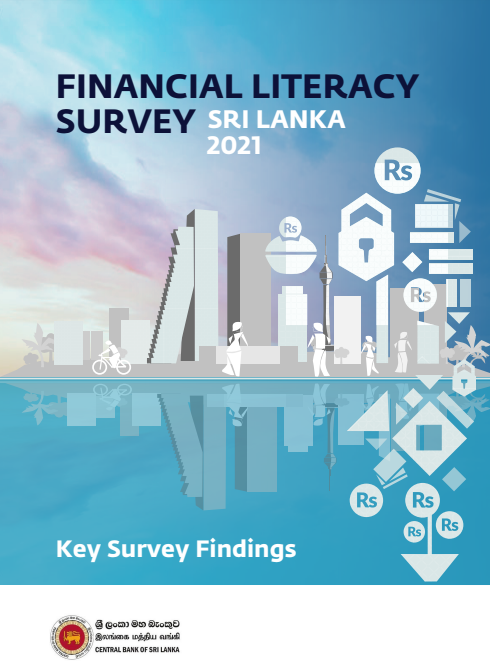The objective of this article is to highlight the pathetic condition of the survey and research skill at the present Central Bank of Sri Lanka (CBSL) based on publication of financial literacy survey 2021 released on 25th October

The CBSL possess huge institutional memory and skills in the conduct of island wide household surveys and release of publications immensely useful for the policymakers, researchers and the general public. The series of Consumer Finances Surveys since 1953 has been the landmark source of data in assessing the socio-economic progress of the post-independent Sri Lanka. The Statistics Department in the CBSL has emerged to carry out a specialized function of surveys and compilation of socio-economic statistics within the CBSL whereas the Economic Research Department has been focusing on policy-focused research.
Having been engaged in several surveys including Consumer Finances Survey, compilation of statistics and research as well as financial sector supervision duties for nearly 17 years continuously, by reading the above publication, I am at a loss to understand how the CBSL has fallen to this pathetic condition in producing statistical information as part of its public mandate.
Before I provide my comments on the definitions and findings published in the above-stated Financial Literacy Publication, their highlights are given below.
Highlights of the CBSL Financial Literacy
1. Financial literacy has been defined as the combination of knowledge, attitudes and behavior necessary to make informed financial decisions and achieve financial wellbeing. The sample size is 4,800 households, but the total number of adults surveyed to assess the literacy level is not indicated in the report.
2. A single indicator of financial literacy level is calculated focusing on the four fundamental concepts for financial decision making, i.e., numeracy, compound interest rate, inflation and risk diversification. A person was defined as financially literate if that person correctly answered at least three out of these four financial concepts.
3. Accordingly, Sri Lankan financial literacy rate of adults aged 18 and above is 57.9%. It is 55.2% for female and 61.1% for male.
4. The overall financial literacy score ranges from 1 to 21. It is the sum of the financial knowledge score (0 to 7), financial attitude score (1 to 5) and financial behavior score (0 to 9).
- Financial knowledge score is based on basic understanding of financial concepts like inflation (definition and impact of inflation), simple and cumulative interest rates, risks associated with investments (Risk diversification and risk-reward) and borrowing.
- Financial attitude score is based on attitudes towards money, money management and planning for the future.
- Financial behavior score is based on savings, short and long-term investment planning, making rational purchases and keeping track of cash flow.
5. The overall financial literacy score for Sri Lanka is 12.12 which shows an ample space for improving the level of financial literacy.
6. Vulnerable groups based on overall financial literacy score – For this purpose, the scores have been estimated for gender, age group, education level, urban/rural and digital use.
A Few Comments
1. I tried to calculate my financial literacy under three categories/scores given in the publication. However, I could not do it as the questionnaire used for the survey has not been given in the publication. The standard practice used in survey reports is to disclose the questionnaire. However, the CBSL is not aware of this general practice. Therefore, the reader has no way to understand the rationale behind the financial literacy rates and literacy scores given in this publication. Accordingly, the reader without the questionnaire does not have the ability to assess the quality of the survey findings or to interpret the findings for applications.
2. There is no meaning of the overall financial literacy score and the finding that 57.9% of adults are financially literate. In the survey, the sum of three scores as shown in para 4 above is the overall financial literacy score which is 12.12 for Sri Lanka. However, the determination of the financial literacy based on this score has no rationale.
- First, this kind of arithmetic summation of three different scores of different scales has no statistical meaning.
- Second, whether the literacy rises or falls on the score from 1 to 21 is not defined. Therefore, the level of the score used to identify adults as financial literate is not stated. This shows that the financial literacy rate of 57.9% is meaningless.
- Third, the report states that 59.49% of respondents are above the overall financial literacy score 12.12. However, the minimum target score is stated as 14. Therefore, how 57.9% of adults is determined as financially literate is not clear, i.e., whether it is based on the overall financial literacy score or four concepts-based indicator state in para 2 above.
- Fourth, how vulnerable groups are identified from these financial literacy rates are not presented in the report although it is mentioned.
3. The report states that the survey was commissioned to assess the level of financial literacy levels of the population with a view to formulating appropriate policy measures. This is a meaningless statement as literacy scores and findings given in the report are baseless. Further, appropriate measures stated therein are not known or commented. As the CBSL is the apex financial sector regulator, it should propose and implement appropriate policy measures based on these findings so that both financial inclusion and monetary policy transmission are improved.
4. The elements considered in the scores of financial knowledge, financial attitude and financial behaviors are seen to be copied from textbook concepts on financial management in developed countries. For example, risk diversification, risk and return, investment planning, inflation and real value of money are found in complex financial management. Even complex investors have different descriptions, attitudes and behaviors on these strategies. Therefore, asking questions on these matters from persons to identify the financial literacy level in a country like Sri Lanka is highly inappropriate.
For example, everybody knows how prices affect their purchasing power in a market environment. But, they do not know different definitions of inflation and the trend of statistical inflation rates as measured from price indices for the purpose of cost of living monitoring. People who invest in crypto-currencies or Ponzi schemes or unlawful investment schemes (latest Thilini Priyamali and crypto currency scam) do so, not because they are financially illiterate, but because they are risk-taking in finance.
5. Therefore, financial literacy should be surveyed on basic skills available with persons and households similar to the concept of the language literacy (reading and writing of a simple sentence in own language). In that context, financial literacy should be defined to cover the familiarity or the usage of the formal financial system for payments, savings, investments and borrowing. Therefore, the definitions should be based on identified transactions and their frequency.
Accordingly, the financial literacy in the countries with dominance in bank intermediation like in Sri Lanka is primarily to gage the familiarity or skills on financial transactions with banks. Availability of a bank account, habit of deposit and withdrawal, the use of ATM/debit card, bank fund transfers, the use of a credit card, the use of internet/APP based banking, etc., can be listed to assess the levels of literacy from the primitive to the advanced. If necessary, investments in stocks, government securities and other instruments can be added to gage the advanced levels of literacy as defined. Therefore, it is simply the survey of savings and investment covered in the Consumer Finances Surveys plus the skills in new payment instruments.
6. However, the CBSL has blindly followed financial definitions of the US Consultants in assessing Sri Lankan financial literacy and, therefore, survey findings are meaningless for any use other than colorful reports. This shows how the present CBSL has fallen to hands of foreign experts. Further, why this survey was conducted by the Regional Development Department while the Statistics Department specially trained for surveys was kept out is questionable on the ground of misallocation of resources.
Concluding Remarks
As commented above, it is clear that the CBSL also does not understand the measurement of financial literacy used as the benchmark to modernize the financial system of Sri Lanka. The reason why the foreign currency reserve was collapsed to almost zero leading to the economic crisis and default of foreign debt is the lack of foreign currency literacy at the CBSL. Further, skyrocketing of interest rates through the monetary policy is also a result of the lack of monetary literacy at the CBSL.
The CBSL goes for government debt restructuring while restructuring of private sector debt in the domestic banking sector is not facilitated yet. Meanwhile, the CBSL also lost a few billion of investments made with a primary dealer in 2016 which is also a financial literacy problem.
The existence of a huge risk of a banking crisis in the currency context is also a result of the lack of financial system literacy of the CBSL as an apex body of the financial regulator and supervisor in the country. The crisis prevention and resolution literacy is another level of financial literacy in countries.
The CBSL has been engaged in a large number of country-wide awareness programmes to improve the financial literacy of the people during the last two decades. Paper notices and “A Guide to Financial Services in Sri Lanka” (first published in 2002 in all three languages) prepared by me under advice of A S Jayawardena, then Governor, were main actions. The Guide was last updated in May 2017 just before my retirement (but the CBSL web carries the Guide published in 2004) whereas new programmes are not heard.
Therefore, it is proposed that the CBSL conduct periodical financial literacy surveys covering a wider sample to gather data on domestic definitions to initiate policies for financial deepening and improvement of monetary policy transmission in the country.

P Samarasiri
Former Deputy Governor, Central Bank of Sri Lanka
(Former Director of Bank Supervision, Assistant Governor, Secretary to the Monetary Board and Compliance Officer of the Central Bank, Former Chairman of the Sri Lanka Accounting and Auditing Standards Board and Credit Information Bureau, Former Chairman and Vice Chairman of the Institute of Bankers of Sri Lanka, Former Member of the Securities and Exchange Commission and Insurance Regulatory Commission and the Author of 10 Economics and Banking Books and a large number of articles published)


